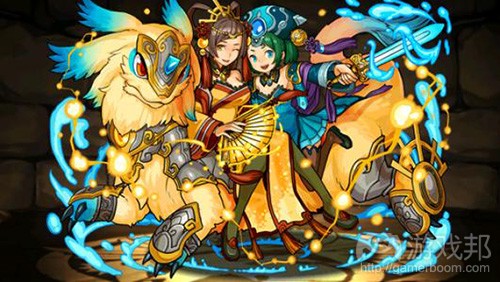关于免费游戏中的Gacha设计
作者:Josh Bycer
最近一款刚发行的任天堂游戏点亮了游戏销量表,即《火焰之纹章》。当《超级马里奥跑酷》选择了背离传统的定价模式时,《火焰之纹章》则利用了gacha或gashapon机制。尽管这两款游戏在战利品设计方面很相似,但后者的gacha功能却值得我们去深入研究游戏。
Gacha:
Gacha设计是基于Gashapon概念:在日本人们可以通过自动贩卖机购买各种玩具。基于不同机器可购买到的玩具质量也不同,但通常情况下如果你花更多钱,你便能够获得更高价值的玩具。在日本,Gacha玩具通常是伴随着常见和稀有的玩具组合而发行。
就像任何收集市场一样,这种机制的吸引力便是去获取你想要的玩具。收集者可以使用该机制去购买组合或与其他收集者交换他们想要的东西。Gacha玩具总是拥有更高的质量。
我们发现一些MMO和零售游戏在一些特殊道具或收集品中都使用了Gacha机制。如《莎木》便是一个早前的例子。这里的要点在于何时Gacha是作为游戏的主要盈利形式。
怪兽:
在收集市场中Gacha非常受欢迎,但是在免费游戏中它却有着不同的寒意。许多来自日本的手机游戏都是围绕着作为进程和盈利方式的Gacha机制进行创造。最典型的例子便是《智龙迷城》。这款游戏中的进程主要基于两条线:收集怪兽和清理地下城。为了战胜每个地下城,你便需要组建一支怪兽团队。
游戏中的怪兽将以不同的稀有度出现,这也会影响到它们的能力和属性。你并不能使用初级怪兽前往高级地下城。而为了壮大团队,你需要凭借运气去获取掉落的蛋或利用“蛋机器”。
游戏的随机事件是可能会添加带有更高掉落率的特殊地下城或能够诞生更稀有怪兽的稀有蛋机器。
对于玩家来说这些事件非常重要,这也是他们获取稀有或特殊道具的有限方式。显然只有消费你通过购买或缓慢赚取的货币才能去使用蛋机器。
接下来我们将谈论Gacha在不同游戏中对于进程的影响。比起不够幸运的人,拥有运气能够帮助你获取掉落物品并更快地前进。虽然战利品盒与Gacha设计很相似,但是它们也具有很大的区别。
战利品盒 vs Gacha机制:
这两种免费设计形式的目标都是为了从消费者那里赚取收益。从执行方面来看,它们的设计模式都是一样的:基于随机数发生器(RNG)区域限制可能的道具。
比起战利品盒,Gacha拥有更广泛的吸引力,但是它们都拥有限时事件。关于这点我们上面已经说过Gacha了,而战利品盒则是围绕着周期性或特殊事件去执行。
而它们的主要区别在于系统与游戏玩法的整合方式。战利品盒通常是基于一款游戏中的价格条件进行标准化。也就是如果一个盒子需要2.99美元才能开启,那么每个盒子的价格便都是如此。
Gacha则会突出不同机器或选择。开发者会通过提供给你更昂贵,但也拥有更高质量的机器让你去花更多钱。还有一种选择是一次提供给玩家奖励或动机让他们花更多钱。在《火焰之纹章》中,你获得英雄的最佳机会便是一次性消费最多魔法球。
而关于进程的一个主要区别便是稀有性层面。只是为了进程而花钱是不够的,你还需要让玩家获得更高质量的奖励。
这便是Gacha在基于群组的游戏中非常受欢迎的原因—-一个最高层面单位是不够的。
这两种盈利形式都基于较小的战利品掉落率而设置了高质量的道具。也就是说它们在盈利进程方面都存在问题。
付钱前进:
关于战利品盒我提到的同样问题也会出现在Gacha设计中。这些游戏将它们的进程模式依赖于玩家愿意花多少货币。更高质量的道具/角色也始终优于较低层面的道具/角色。
当你开始在游戏中前进时,前面将会有一堵稀有墙阻挡了你的去路。因为这些游戏是关于抽象设计,所以这种情况没办法去改变。这也是为什么游戏经常会清除玩家进程并在他们于一开始获得最佳道具时让其重新开始。
因为进程与稀有性的紧密相连,开发者可以通过添加更多层面,更多角色与更多方式让玩家去花钱而不断发展游戏。
博彩:
可以说Gacha和战利品盒设计都是很成功的盈利方式,但对于我来说却不是如此。我觉得将进程与盈利捆绑在一起会让我们将更多注意力从游戏挪向谁拥有更多钱。
当提到化妆道具时,Gacha和战利品盒都可以在不影响游戏设计的前提下让玩家花钱。让我们期待之后的《火焰之纹章》会怎么做以及基于Gacha设计下的游戏将如何发展吧。
(本文为游戏邦/gamerboom.com编译,拒绝任何不保留版权的转发,如需转载请联系:游戏邦)
A Look at Gacha Design in F2P Games
by Josh Bycer
Another Nintendo Mobile game was released recently and is lighting up the sales charts: Fire Emblem Heroes. While Super Mario Run was unconventional with its pricing model, Fire Emblem is making use of “gacha” or “gashapon.” Even though they are similar to loot box design, gacha features some unique twists for us to look at.
Getting Gacha:
Gacha design is based on the concept of Gashapon: Vending machines in Japan that give out a variety of toys. The quality of the toy varies based on the machine, but typically the more money you spend, the higher the possible value. In Japan, Gacha toys are typically released in a series of sets with common and rare toys to get.
As with any collectible market, the hook is getting the toys and sets that you want. Collector’s could play the machines, buy sets, or trade with other collectors for the ones they want. Gacha toys tend to be of a higher quality compared to our machines.
We’ve seen MMOs and retail games make use of Gacha for special items or collectibles; with Shenmue being an early example. The major point is when Gacha is used as the main form of monetization in a title.
Monster Mash:
Gacha is popular among the collectible market, but takes on a different meaning in the F2P one. Many mobile games from Japan are built around Gacha as a form of progression and monetization. The most famous example from Japan is Puzzle and Dragons. Progression in this game is done on two fronts: Collecting monsters and clearing dungeons. In order to beat each dungeon, you need to assemble a team of monsters.
Monsters in the game come in different rarities which affect their utility and stats. You’re not going to be able to get through the advanced dungeons with your starting monsters. To grow your team, you need to get lucky with monster egg drops or make use of “egg machines.”
Events take place that either add in special dungeons with a higher drop rate, or rarer egg machines that can drop higher rarities of monsters.
The events are a big deal and are a limited time way of possibly getting something rare or unique. Obviously, it’s going to cost you premium currency which you can buy or earn slowly in order to use the egg machines.
As we’re going to talk about next, Gacha has a major impact on progression through the respective games. Getting lucky with drops can afford you a lot of progression compared to someone who is unlucky. Loot Box and Gacha design are similar, but they feature some differences.
Loot Box vs. Gacha:
Both forms of F2P design were developed with the intent of getting money from the consumer-base. In terms of implementation, the designs of both are modeled the same: Limiting possible items based on RNG.
Gacha tends to have a wider draw compared to loot boxes, but both have limited-time events. We’ve already talked about Gacha, but loot boxes can be released around seasonal or special events.
Where they differ and the major point is how the system is integrated into the gameplay. Loot boxes are typically standardized in terms of pricing within a single game. If one box costs $2.99 to open, then every box will cost the same.
Gacha features different kinds of machines or options. The developers condition you to spend more money in one way by having machines that cost more to use, but have higher quality. Another option is to provide bonuses or incentives for spending more money at a time. In Fire Emblem Heroes, your best chance for getting heroes is to spend the most orbs at a time for the random five draw.
One major difference that figures into progression is rarity tiers. It’s not enough to just spend money for progress; you need to get higher quality picks.
This is why Gacha is popular among party-based games, because one highest tier unit is not enough.
Both forms of monetization put the carrot of high quality items out there, with a very small drop rate to boot. With that said, they also show the major problem in terms of monetized progression.
Pay to Progress:
The same issue I talked about with loot boxes is also seen in Gacha design. These games base their progression models on how much premium currency someone is willing to spend. The higher quality items/characters are always better than the lower tiers.
While you may start out making progress, there is always a rarity wall that will stop you in your tracks. Because these games are about abstracted design, there’s not much you can do to improve. This is why there is a common practice of erasing your progress and starting over until you get a good draw at the start.
With progression tied to rarity, this makes it very easy to keep growing the game by adding in more tiers, more characters and more ways to spend money.
The Lottery:
Ultimately Gacha and loot box design are successful forms of monetization, but they’re not for me. Progression tied to monetization I feel takes too much away from playing a game, and focuses on who has the most money.
When it stays to cosmetic/aesthetic items, Gacha and loot boxes are an effective way of getting people to spend without impacting the design. It’s going to be interesting to see how Fire Emblem Heroes will do beyond the launch phase, and where things will grow with its Gacha design.(source:gamasutra)
下一篇:电子游戏需要停止纠结于乐趣中








































 闽公网安备35020302001549号
闽公网安备35020302001549号